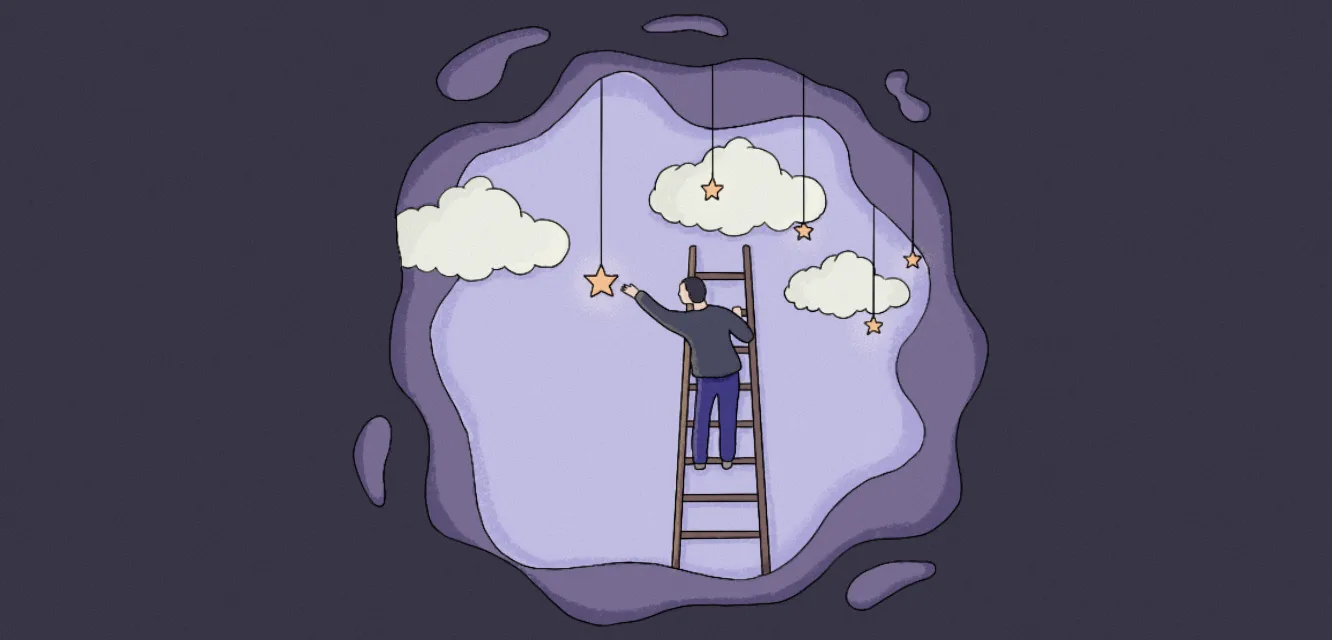
Denys Chumak
19 Jul 2023
What is Lucid Dreaming?
Introduction
Lucid dreaming is a phenomenon that has fascinated humans for centuries. Imagine being aware that you are dreaming while you are in the midst of a dream, having the ability to consciously control and manipulate the dream experience. This is precisely what lucid dreaming entails. A 2016 meta-analysis of 34 studies found that 55% of over 24,000 people reported having experienced lucid dreams at least once in their lifetime.
In this comprehensive guide, we will what does lucid dreams mean and the scientific understanding of techniques for inducing lucid dreams and the potential benefits of this extraordinary experience.
What is Lucid Dreaming?
Lucid dreaming refers to the state of being aware that you are dreaming while you are still within the dream itself. Unlike regular dreams where we often passively observe or participate without realizing their dream nature, lucid dreams grant us a heightened level of consciousness, allowing us to recognize the dream as a construct of our own mind. This newfound awareness opens up a realm of possibilities, where we can actively influence and shape the dream world according to our desires.
How Does Lucid Dreaming Work?
The exact mechanisms behind lucid dreaming are still being explored by scientists and researchers. However, it is believed to involve a unique interplay between different brain regions and neurotransmitters. During a lucid dream, the prefrontal cortex, responsible for self-awareness and logical thinking, becomes more active, leading to the realization that one is dreaming. This activation allows individuals to exert control over the dream environment and engage in intentional actions.
Techniques for Inducing Lucid Dreams
Now that you’ve very well understood lucid dreaming meaning and how it works, let us explore its techniques. Lucid dreaming can occur spontaneously for some individuals, while others may actively seek to induce lucid dreams through various techniques. Here are some popular methods that can increase the likelihood of experiencing lucidity during sleep:
1. Reality Testing: Regularly question your reality during waking hours by performing reality checks. Ask yourself, "Am I dreaming?" and look for any inconsistencies or abnormalities in your surroundings. This habit may carry over into your dreams, triggering lucidity.
2. Mnemonic Induction of Lucid Dreams (MILD): Before sleep, repeat a mantra or affirmation, such as "I will have a lucid dream tonight," while visualizing yourself becoming lucid. This practice enhances your intention and can influence your dream state.
3. Wake-Induced Lucid Dreaming (WILD): Wake up after a few hours of sleep and then attempt to enter a lucid dream directly. Stay mentally alert while transitioning back to sleep, focusing on maintaining awareness as your body drifts into the dream state.
4. Keeping a Dream Journal: Record your dreams in a journal immediately upon waking. This practice improves dream recall and increases overall awareness of dream patterns, making lucid dreaming more accessible.
5. Sleep Hygiene and Wakefulness: Maintain a consistent sleep schedule and prioritize quality sleep. Avoid excessive caffeine and stimulants close to bedtime, as they can interfere with dream recall and lucidity.
Also Read: What Does it Mean When You Dream About a Goat?
Benefits and Applications of Lucid Dreaming
Lucid dreaming not only offers an exhilarating and immersive experience but also holds potential benefits in various aspects of life:
1. Creative Exploration: Lucid dreaming provides a platform for creative exploration, where you can engage in artistic endeavours, problem-solving, and idea generation within the boundless landscape of your dreams.
2. Personal Growth and Self-Discovery: Lucid dreams can serve as a tool for personal growth, self-reflection, and exploration of the subconscious mind. By consciously navigating the dream realm, individuals can gain insights into their emotions, fears, and aspirations.
3. Overcoming Nightmares and Phobias: Lucid dreaming techniques can be used to confront and overcome recurring nightmares or phobias by actively changing the dream narrative and transforming fearful situations into positive experiences.
4. Skill Enhancement: Some individuals have reported using lucid dreaming to practice and improve real-life skills, such as public speaking, sports techniques, or creative performance.
5. Emotional Healing: Lucid dreaming may offer a unique opportunity for emotional healing and resolution. By revisiting past experiences or engaging in therapeutic scenarios, individuals can process and integrate unresolved emotions within the safe confines of the dream world.
Exploring the World of Lucid Dreaming
While the concept of lucid dreaming may initially seem elusive or fantastical, it is a genuine and scientifically recognized phenomenon. With practice and dedication, anyone can develop the ability to experience lucid dreams. By embracing this extraordinary state of consciousness, you can embark on a captivating journey of self-exploration, creativity, and personal growth. So, dive into the world of lucid dreaming and unlock the limitless possibilities that lie within your own dreamscape.
Common Dreams
Lucid dreams can encompass a wide range of experiences and scenarios, limited only by the imagination of the dreamer. While the possibilities are virtually endless, there are some common dreams that people often encounter. Here are a few examples:
1. Flying: Flying is a popular and exhilarating experience in lucid dreams. Many people use their lucid dreaming abilities to soar through the skies, feeling a sense of freedom and liberation as they explore the dream world from above.
2. Dream Control: One of the defining aspects of lucid dreaming is the ability to control the dream environment and manipulate its elements. People often enjoy experimenting with their powers, such as summoning objects or characters, changing the scenery, or altering the laws of physics within their dreams.
3. Superhuman Abilities: Lucid dreams provide an opportunity to experience extraordinary abilities that defy the limits of reality. Some individuals may choose to showcase superhuman strength, telekinesis, or the ability to manipulate elements like fire or water.
4. Time Travel: Lucid dreams can also allow for time travel, where dreamers can visit different eras, and historical events, or even explore the future. It provides a unique opportunity to experience different time periods firsthand and interact with people or environments from the past or future.
5. Dream Exploration: Lucid dreams offer a chance to explore the dream world in its entirety. Some individuals enjoy delving into the intricacies of dream landscapes, discovering hidden realms, or interacting with dream characters to uncover deeper meanings or messages within their dreams.
6. Meeting Deceased Loved Ones: For some, lucid dreaming provides a means to reconnect with departed loved ones. In a lucid dream, people may intentionally seek out and engage in conversations or interactions with deceased family members or friends, offering a sense of closure or continued connection.
7. Creative Expression: Lucid dreams serve as a canvas for creative expression. Many artists, writers, and musicians have used their lucid dreaming abilities to gain inspiration, create art, compose music, or explore new forms of expression that can be translated into their waking lives.
It's important to note that individual experiences can vary significantly, and each person's lucid dreams are unique to their own subconscious mind. The beauty of lucid dreaming lies in the freedom to explore and create within the vast realm of the dream world, making each lucid dream a truly personal and extraordinary experience.
Also Read: The Top 10 Most Common Dreams and Their Meanings
Conclusion
In conclusion, lucid dreaming is a remarkable phenomenon that offers a gateway to a world where imagination and consciousness intertwine. It is a state where we can become active participants and creators within the realm of our dreams. While the exact mechanisms of lucid dreaming are still being explored, techniques such as reality testing, MILD, WILD, dream journaling, and maintaining good sleep hygiene can enhance our chances of experiencing this unique state of awareness.
Do you ever wish you could control your dreams and experience incredible adventures while you sleep? Well, it's time to turn your dreams into reality with the amazing DreamApp! This unique app aims to assist you in delving into the depths of your subconscious and harnessing the potential of lucid dreaming.
Frequently Asked Questions
Q: What does lucid dreams mean and how it differs from regular dreams?
A: In a regular dream, individuals are often unaware that they are dreaming and have no control over the dream events. However, in a lucid dream, the dreamer becomes consciously aware that they are in a dream and can actively influence and manipulate the dream environment.
Q: Are there any risks or drawbacks to lucid dreaming?
A: Generally, lucid dreaming is considered safe and enjoyable. However, some individuals may experience difficulties distinguishing between dreams and reality upon waking up, which can cause temporary confusion. It is important to maintain a healthy sleep routine and seek professional advice if you encounter any persistent sleep-related issues.
Q: Can lucid dreaming improve sleep quality?
A: Lucid dreaming itself does not directly affect the quality of sleep, as it occurs during the REM (rapid eye movement) stage, which is already a vital part of the sleep cycle. However, practising techniques for lucid dreaming, such as maintaining a dream journal or practising relaxation exercises, can promote overall sleep hygiene, leading to better sleep quality.
Q: Can lucid dreaming be used for therapeutic purposes?
A: Lucid dreaming has shown potential therapeutic applications, such as treating nightmares, PTSD (post-traumatic stress disorder), and recurring dreams. It can provide a platform for individuals to confront and process their emotions, fears, and traumas within the safe environment of a dream.
Did you have an unusual dream with this symbol?
Let's analyze this dream with our expert!
At least five words, please.

Your dreams are completely private
Take control of your dream emotions in the free mobile app



The most recent users' dreams
Go to the user dreams page
Dream App
Free dream interpretations

(1,213)











